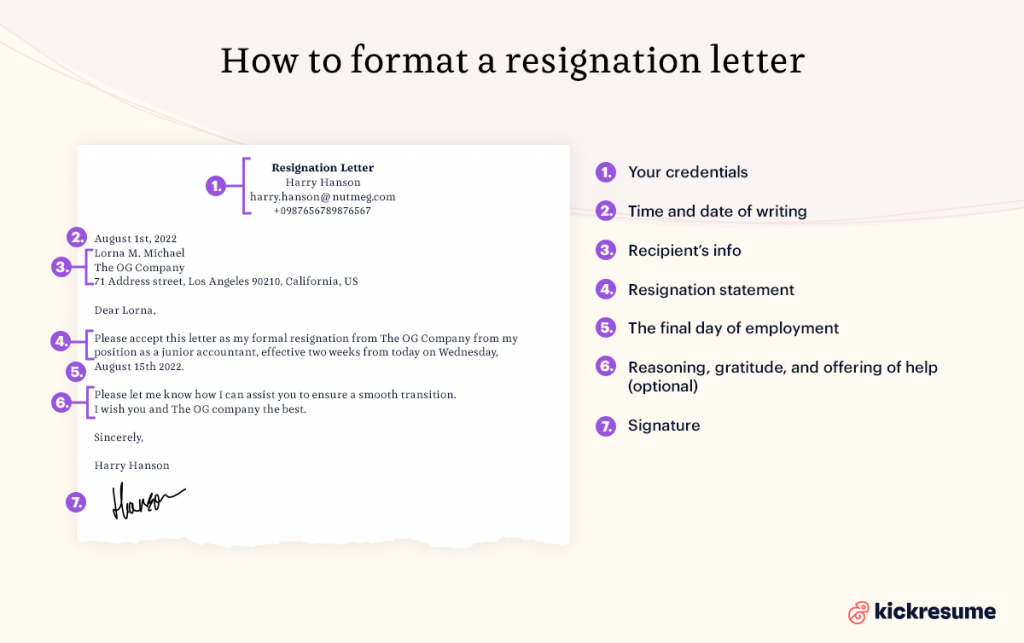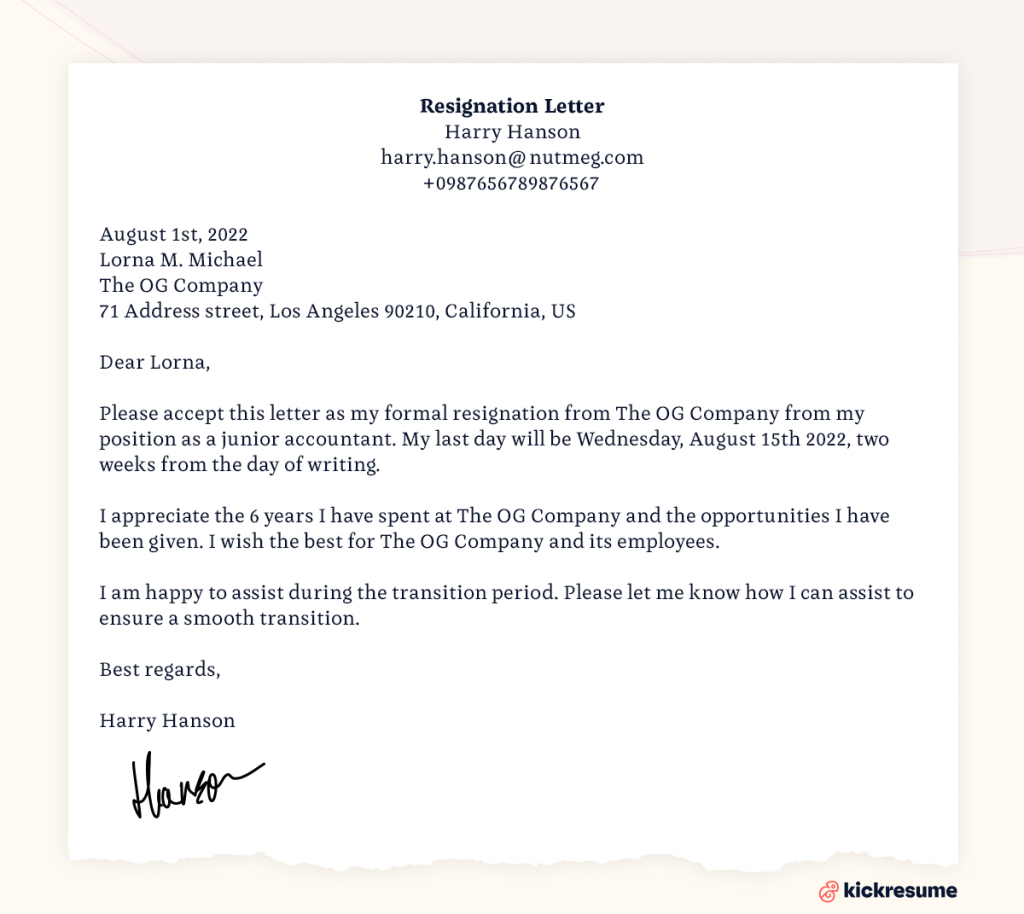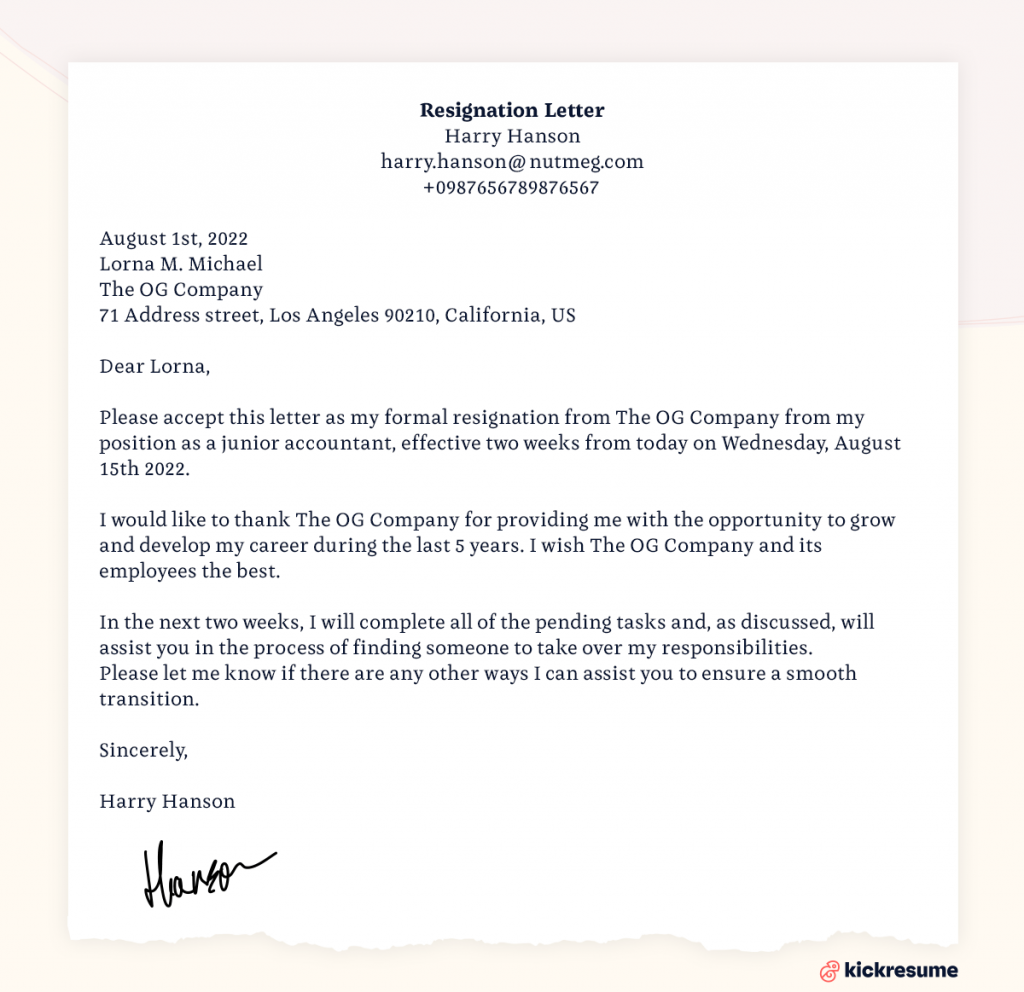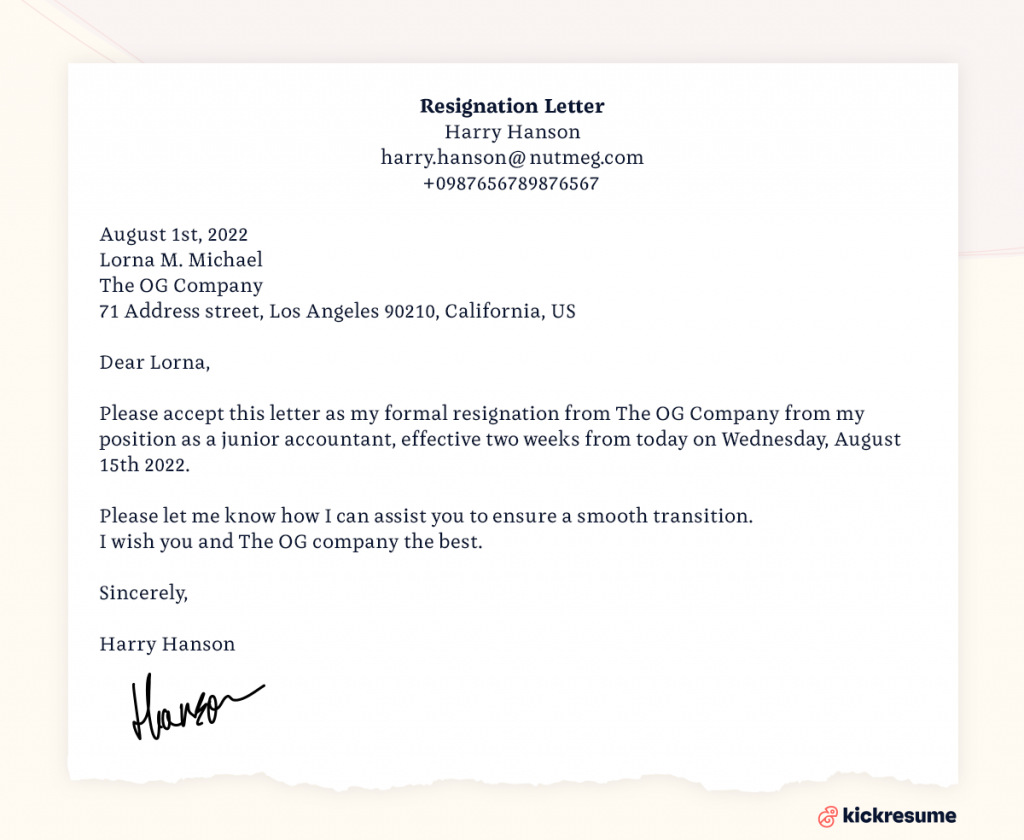A recent Microsoft report found that 52% of the millennial and Gen Z workforce is likely to consider quitting and handing in their resignation letter in the coming year — up 3 percentage points since last year.
Resigning from a job can be bittersweet.
On one hand, you're probably excited about your new job and happy to leave your old one. On the other hand, there's still plenty of bureaucracy and uncomfortable conversations ahead of you.
Quitting a job looks easy in movies, however, in reality, there are some important steps you should follow.
So, how to quit a job in a legally-sound and graceful way?
Well, having a conversation with your employer, giving a two-week notice, and writing a resignation letter are the key steps that allow you to quit a job gracefully and without any potential conflicts.
This article will cover these steps in more detail, show you how to write a good resignation letter, and provide you with resignation letter templates and samples.
- What is a resignation letter?
- What is a two weeks notice letter?
- How to write and format a resignation letter?
- Basic resignation letter examples
- Resignation letter template for every occasion
- Common resignation letter mistakes and what not to include
- How to write a resignation email (+example)
- Goodbye email to coworkers (+example)
What is a resignation letter?
First things first, a resignation letter is the official formal document that lets your employer know you're quitting your job.
Now, why is this important if you've already told them in person?
Basically, anything that's been discussed but isn't recorded on paper can later be disputed, twisted, and lead to potential conflict. So, if you want to maintain professionality and make sure that your employer is sticking to what's been discussed, you should write a letter of resignation.
In short, it serves as a way to avoid any potential arguments.
Apart from being a formal document, a resignation letter also helps HR to stay organized. It serves as a reference for them, regarding details like the last day of employment or resignation notice period.
Last but not least, a letter of resignation can also include your reason for quitting. However, it's not always necessary.
You should write a resignation letter in a professional and formal way. Thus, there are some key components each letter should include. These are discussed in a later section “How to Write And Format a Resignation Letter”.
Later in the article, you will also find resignation letter samples and templates.
What is a two weeks notice letter?
A two weeks notice letter is sometimes called the two weeks resignation notice (letter). This means that, in essence, it's the same thing as a resignation letter.
Sometimes these two are referred to as separate documents, with a resignation letter stating the reasoning behind your departure, and a 2 weeks notice letter specifying the date of your last day of employment and your notice period.
However, there is no need to create two different documents if not specified otherwise. Doing so will only create more work for everyone involved and can cause confusion.
Instead, it's common practice to include all the necessary information in one document — the resignation letter.
Therefore, perhaps a better question is, what is a notice period?
A notice period is the period of time starting when you hand in your resignation letter until your last day at the job.
In some countries giving a notice period to your employer is legally binding, with individual employers specifying the length of the period in contracts.
However, in the US, neither the employer nor the employee has to give any notice for ending the working relationship. Basically, no legally binding notice period is required in the United States.
That being said, it's common courtesy that you provide a two weeks notice at least.
So, what do you need to do?
Hand in your resignation letter at least two weeks before ending your work relationship, including the end date in the letter. This will count as giving your employer a 2 weeks notice and will ensure a smooth transition period.

How to write and format a resignation letter?
There are some key components each letter should include. These are:
- Your credential is at the top.
Your name, mobile number, and email should do. An address is optional.
- Time and date of writing.
This is important for keeping a record of when you officially resigned from the job and from what date your notice period begins.
- Address the recipient.
It’ll usually be your direct manager or an HR manager. Include the company name and address, and the name of the recipient.
- Resignation statement.
No need to be creative or too emotional, simply write one or two sentences stating that you will be resigning from your current position at the given company.
- The final day of employment.
To remain professional, let this be at least two weeks from the date of writing the letter. This counts as the notice period, which is a common practice and ensures the relations remain positive and professional.
- Reasoning, gratitude, and offering of help.
This isn’t a necessity and you can skip this. However, if you ended your employment on good terms, it’ll definitely be appreciated and score you good points and possibility for a future reference. Perhaps offering your help during the transition period is the one to keep in the letter, if anything.
- Signature.
Simply say “Sincerely,” or “Best regards,” and sign your name by hand or add a digital signature. Remember this is an official document.
The key components of a resignation letter outlined above can be tailored to specific circumstances of your departure from the job.
However, every basic resignation letter should, at minimum, include these.
Basic resignation letter examples
This section includes templates and examples of specific resignation letters you can download and use to save you some time and nerves in this already stressful time.
Standard resignation letter sample #1
This standard resignation letter sample contains all of the necessary components. It provides the information, clearly states the purpose, and shows appreciation for the company. Finally, it also offers help.

Basic resignation letter sample #2
This basic resignation letter example shows an alternative way of phrasing your letter while keeping all of the necessary components.
It's good to mention some strategies you've discussed with your manager, such as what the plan is for your last two weeks.

Short resignation letter sample #3
A resignation letter is, after all, just a formal document. It only really needs to contain the dates for giving a two weeks notice and your resignation statement.
So, if you're really eager to leave and excited to resign from your old job, whatever the reason may be, it's completely okay to write a minimalistic resignation letter. No need to expand on anything else.

Resignation letter template for every occasion
In the previous section, we've provided you with example resignation emails. In this section, we offer resignation letter templates for every occasion.
Simply copy the text and fill in your information and details.
Resignation Letter
Common resignation letter mistakes and what not to include
In this section, we'll look at the common resignation letter mistakes to avoid and discuss what not to include in one.
While a resignation letter is a pretty short and standard document. But sometimes you may be tempted to go the extra mile and include things that are really best left out.
Without further ado, here are the common resignation letter mistakes:
- Don't forget to write a resignation letter.
- To who do you address a resignation letter?
- Not giving a notice.
- Don't mention your new job.
- Don't be petty.
- Avoid writing long explanations for your resignation.
- Never list the reasons you hated your job/boss/company.
- Don't be emotional and informal.
Let's have a closer look at these mistakes and things to avoid when writing a resignation letter.
- Don't forget to write a resignation letter. Pretty self-explanatory. A resignation letter is a really important formal document and you should hand it in when resigning from a company. Failing to provide one will seem unprofessional and may even lead to conflict regarding payroll. So, write the letter, look at the templates below, sign it off, stick the resignation letter in an envelope, and hand it in.
- To who do you address a resignation letter? Should you address the resignation letter to HR or your boss? While you may think you should write directly to the CEO or owner of the company, this is a mistake most of the time. If you work in a large company, the CEO may not even know you, and they surely don't handle issues like resignations. Hence, it's best to address your resignation letter to your reporting manager or an HR manager. If you're not sure, your best bet is to go and ask.
- Not giving a notice. You may be wondering how much time you need to give notice for your current position. In short, at least two weeks. It's really unprofessional to not give notice at all, even though in the US it's not legally bound. Again, have a discussion with your supervisor and reach a common ground. It may have to be longer or shorter than 2 weeks.
- Don't mention your new job. Even though it may be tempting to boast a little, you never know how things will play out. To avoid any awkwardness if your new job doesn't work out, just avoid saying anything about your plans. Remember, you are under no obligation to disclose this information.
- Don't be petty. Try to resist throwing in a petty remark even if you really want to. You never know when you'll need a reference or how things may play out. It's best to leave on good terms and leave the door open.
- Avoid writing long explanations for your resignation. While you can mention in a sentence or two your reasoning, it's best to discuss the details and the whole situation that lead you to quit directly with the manager. It's not the purpose of the resignation letter to provide this explanation.
- Never list the reasons why you hated your job/boss/company. Yes, this may be cathartic. But it's also absolutely pointless. You should discuss these with your boss in private rather than write about them in a letter, the sole purpose of which is to provide an end date of your employment for bureaucratic grounds.
- Don't be emotional and informal. A resignation letter is a formal document, recording your date of employment termination and your notice period. Period. It's not a space for sentiment, jokes, or insults. Be professional and avoid such language.
How to write a resignation email (+example)
Even though the best way to hand in your resignation letter is in-person and on paper, sometimes this is not really possible.
Nowadays, more and more people work remotely or have a flexible work schedule, which makes it hard to meet in person.
In such cases, the best way to handle your resignation is via email. Aim to have an in-person discussion with your employer to inform them about your plan to resign. Then send them a resignation letter in an email.
So, how to send a resignation email?
This section provides helpful tips for crafting the best resignation email letter and offers a sample resignation email as well.
- To whom should the resignation email be addressed? You should address the email to your reporting manager. CC an HR manager responsible for handling resignations.
- Resignation email subject line. Wondering how to title a resignation email? No need to get too creative, simply say “Resignation” or “Resignation - Your Name” in the subject line.
- Resignation email as an attachment? It's really up to you if you want to attach the resignation letter to the email. Or you can write it directly in the body of the email. Attaching the letter might work better since the HR manager can simply download it, print it out, and put it in their records.
- Include resignation statement and notice. These are the two essential components of a resignation letter. So you should really include them in the resignation email. A notice includes the day of writing (which is recorded in the email by default) and stating your last day of employment. This should be at least 2 weeks from the day you sent the resignation email.
- Make it short and professional. No need to include any details of why you decided to leave and what your plans are. If you feel the need, discuss these in person.
- Express gratitude and offer help with the transition. Again, don't ramble too much about how grateful you are. It's completely fine to mention it in a sentence or two. However, remember this is a formal document with no place for too much sentiment.
- Follow up. If you don't hear from anyone in a day or two, there's a good chance something went wrong with the email. It may have been delivered to spam, or you made a typo in the recipient line. This is why it's important to send a follow-up email.
If you're still left wondering how to write a resignation email, please have a look at the sample resignation email below.
Resignation letter email sample
Goodbye email to coworkers (+example)
Leaving a job can be exciting, for sure, but oftentimes it can also be a bit sad. Especially if the reason you decided to leave was something other than a bad relationship with your colleagues.
In fact, according to the 2021 survey on workplace friendship and happiness, 57% of people say having a best friend in the workplace makes work more enjoyable. 22% feel more productive with friends.
Basically, I think we can all agree that having a work buddy does, indeed, make life easier and helps us strike a better work-life balance.
So, when the time comes and you have to leave behind your work friends, you shouldn't forget to say goodbye to them. You never know when you might need someone in your network to provide a helping hand.
And rather than having to send a goodbye email to 50 people individually, just send one that is really well-crafted to all of them at once.
Just like this one:
Example goodbye email to coworkers
Resignation letter FAQ
- 1. What to say when resigning?
The two things you're obliged to say/do when resigning are giving your 2 weeks notice and telling your reporting manager that you're leaving the job. You're not obliged to explain why or what your next plans are. So what you should do is: 1) have a conversation with your boss or direct supervisor and 2) send a resignation letter two weeks before leaving, stating you're officially resigning and your last day of work. That's all.
- 2. How to start a resignation letter?
Firstly, write the title “Resignation letter” and insert all of your credentials — your name, your mobile number, and your email. Next, write the date, the name of the recipient, and the company's name and address. Finally, open the email with a greeting, such as “Dear Jerry,”.
- 3. How to end a resignation letter?
No need to get creative, simply go with “Sincerely,” or “Best regards,” and your name in the following line.
- 4. Who to address the resignation letter to?
It's always best to check with someone from HR if there's a specific person in charge of resignations. If not, address the letter to your reporting manager or the head of HR. In smaller companies, you can address your resignation letter to your boss directly.



